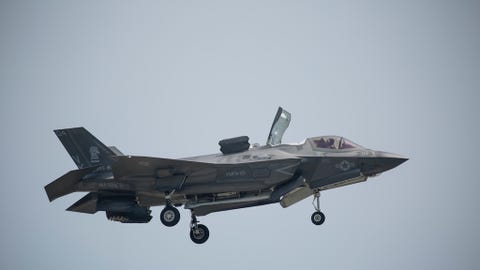Some F-35s Could Become Unflyable by 2026
Structural cracks could limit early production F-35s to nearly a quarter of their planned service lives.
By Kyle Mizokami U.S. MARINE CORPS PHOTO BY CPL. DESEREE KAMM
U.S. MARINE CORPS PHOTO BY CPL. DESEREE KAMMA handful of F-35 Joint Strike Fighters built during the early days of the program could become unflyable by 2026, after just 2,100 flight hours—another embarrassing piece of news for the troubled program. The culprit is almost certainly the F-35’s design and production plan, which involving starting to build the planes before the final design specifications were set. A fix to keep the aircraft in the air is in the works.
According to Aviation Week and Bloomberg News, a static test (non-flying) version of the F-35B—the Marine Corps' vertical takeoff and landing version—has developed multiple structural cracks during durability testing. The static test plane, BH-1, was built to the same standard as early F-35Bs, though redesigns since then have made more recently built planes more durable.
Each F-35B is supposed to have a service lifetime of 8,000 hours. But this operational test and evaluation report on the F-35 suggests that early model F-35Bs could be limited to just 2,100 hours, which means the fighters would start aging out by 2026. The 8,000-hour lifespan is about typical for combat aircraft, with the F-15 and F-16 fighters originally rated for 8,000 and 9,000 hours, respectively.
As is the case with many F-35 problems and cost overruns, you can blame the Pentagon’s use of "concurrency" to field the F-35. Under the concurrency concept, the Pentagon and Lockheed Martin started building the jets before the development process was finished. This was done to warm up production lines and supply chains and get the aircraft into the hands of pilots who could start training early.
Concurrency carries big risks. Aircraft built before the final design standards were set in stone would need hardware and software updates, and determining which planes needed what to bring them up to the final standard will be a complicated and expensive endeavor. Although engineers have identified changes that could keep early model F-35Bs flying the full 8,000 hours, we don’t know the complexity and cost of such an upgrade.
No comments:
Post a Comment